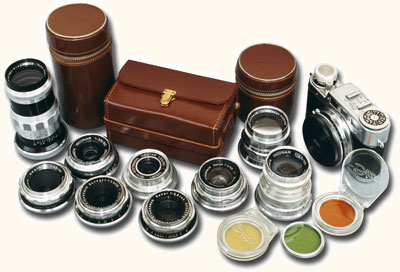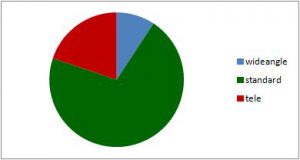Interchangeable lenses for Diax Ia/IIa and Diax Ib/IIb (regularly sold)
All lenses have the same size of filter screw-in: 40,5mm and filter slip-on: 42mm
Diax-a-lenses with engraving „Diax“ on focussing ring can also be used with b-cameras -and vice versa – since the distance to the focal plane is the same. Only the indices will be tilted to a degree of 90°.
In general the Diax-b-lenses were of the same types as for the Diax a-cameras, but Diaxar 1:3,5/50mm and Xenar 1:2,8/45mm were not made in Diax-b-version.
In total there have been 6 focal lengths and 11 specific lens type (see below).

Wideangle:
- Made for Ia, IIa, Ib, IIb
XENAGON (1:3,5/35mm) made by Schneider-Kreuznach, a four-lens Tessar-type, brass mounting, chrome, parallel guided helical focussing(no sun-shade neccessary). - Made for Diax-b-cameras:
WESTRON (1:3,5/35mm) made by ISCO-Göttingen, a four-lens Tessar-type, lightalloy, parallel guided helical focussing(no sun-shade neccessary). This lens was only made in Diax b -version but can be used with Diax-a-cameras as well.
Normal:
- DIAXAR (1:3,5/50mm) made by Laack, a three-lens Taylor-type, lightalloy, frontlens setting. Only to about autumn 1952 with Diax Ia, then replaced by Westar.
Note: As a precaution this lens should not be used with Diax IIa/IIb (with rangefinder), because it may probably cause damage depending on how the couple-pin’s mechanical parts are adjusted!
- WESTAR (1:3,5/50mm) made by OWG/ISCO-Göttingen, a three-lens Taylor-type, lightalloy, frontlens setting. The very early lenses of this type show OWG for Optische Werke Göttingen, then ISCO is common.
Note: As a precaution this lens should not be used with Diax IIa/IIb (with rangefinder) as it may probably cause damage depending on how the couple-pin’s mechanical parts are adjusted!
- ISCONAR (1:3,5/50mm) made by ISCO-Göttingen, a three-lens Taylor-type, brass mounting, chrome, parallel guided helical focussing
- XENAR (1:2,8/45mm) made by Schneider-Kreuznach, a four-lens Tessar-type, brass mounting, chrome, parallel guided helical focussing
- from end of 1954:
XENAR (1:2,8/50mm) (same features as Xenar 45mm) - XENON (1:2/50mm) made by Schneider-Kreuznach, a six-lens-Gauss-type, brass mounting, chrome, parallel guided helical focussing
Tele:
- ISCONAR (1:4,5/85mm) made by ISCO-Göttingen, a three-lens Taylor-type, lightalloy, parallel guided helical focussing
- TELE-XENAR (1:3,5/90mm) made by Schneider-Kreuznach, a Tessar-type construction, heavy brass mounting, chrome, parallel guided helical focussing
- TELE-XENAR (1:4/135mm) made by Schneider-Kreuznach, a Tessar-type construction, lightalloy, parallel guided helical focussing
Today Diax lenses quite often show damages. Filter threads may come deformed or even broken, which may indicate a severe drop to the ground. Reason for such drops may be that the lens wasn’t attached properly and safely to the camera. This may be tricky if the fastening ring on the lens is slightly deformed which makes lens attaching unreliable. Sudden drops are possible, so be sure to observe a proper lens attachment.
Rates of wideangle-, standard- and telelenses in my database (2017):

Although there is no final evidence to production numbers it may indicate that wideangle- and tele-lenses have been significantly less common.
Contents © Dr. Peter Geisler